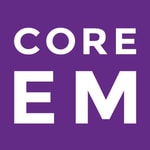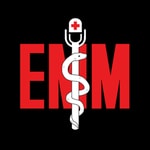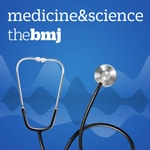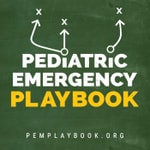Core EM - Emergency Medicine Podcast – Details, episodes & analysis
Podcast details
Technical and general information from the podcast's RSS feed.

Core EM - Emergency Medicine Podcast
Core EM
Frequency: 1 episode/17d. Total Eps: 217

Recent rankings
Latest chart positions across Apple Podcasts and Spotify rankings.
Apple Podcasts
🇨🇦 Canada - medicine
28/07/2025#67🇺🇸 USA - medicine
28/07/2025#69🇨🇦 Canada - medicine
27/07/2025#45🇺🇸 USA - medicine
27/07/2025#65🇨🇦 Canada - medicine
26/07/2025#62🇬🇧 Great Britain - medicine
26/07/2025#93🇺🇸 USA - medicine
26/07/2025#49🇨🇦 Canada - medicine
25/07/2025#72🇬🇧 Great Britain - medicine
25/07/2025#56🇺🇸 USA - medicine
25/07/2025#45
Spotify
No recent rankings available
Shared links between episodes and podcasts
Links found in episode descriptions and other podcasts that share them.
See all- http://www.apple.com
667 shares
RSS feed quality and score
Technical evaluation of the podcast's RSS feed quality and structure.
See allScore global : 48%
Publication history
Monthly episode publishing history over the past years.
Episode 199: Ataxia in Children
Episode 199
jeudi 1 août 2024 • Duration
We discuss a case of ataxia in children and how to approach the evaluation of these pts.
Hosts:
Ellen Duncan, MD, PhD
Brian Gilberti, MD
Introduction
- The episode focuses on ataxia in children, which can range from self-limiting to life-threatening conditions.
- Pediatric emergency medicine specialist shares insights on the topic.
The Case
- An 18-month-old boy presented with ataxia, unable to keep his head up, sit, or stand, and began vomiting.
- Previously healthy except for recurrent otitis media and viral-induced wheezing.
- The decision to take the child to the emergency department (ED) was based on acute symptoms.
Differential Diagnosis
- Common causes include acute cerebellar ataxia, drug ingestion, Guillain-Barre syndrome, and basilar migraine.
- Less common causes include cerebellitis, encephalitis, brain tumors, and labyrinthitis.
Importance of History and Physical Examination
- A detailed history and physical exam are essential in diagnosing ataxia.
- Key factors include time course, recent infections, signs of increased intracranial pressure, and toxic exposures.
- Look for signs such as bradycardia, hypertension, vomiting, and overall appearance.
Diagnostic Workup
- Initial tests include point-of-care glucose and neuroimaging for concerns about trauma or increased intracranial pressure.
- MRI is preferred for posterior fossa abnormalities,
Episode 198: Hypernatremia
Episode 198
lundi 1 juillet 2024 • Duration
We discuss the approach to diagnosing and managing hypernatremia in the emergency department.
Hosts:
Abigail Olinde, MD
Brian Gilberti, MD
Episode Overview:
- Introduction to Hypernatremia
- Definition and basic concepts
- Clinical presentation and risk factors
- Diagnosis and management strategies
- Special considerations and potential complications
Definition and Pathophysiology:
- Hypernatremia is defined as a serum sodium level over 145 mEq/L.
- It can be acute or chronic, with chronic cases being more common.
- Symptoms range from nausea and vomiting to altered mental status and coma.
Causes of Hypernatremia based on urine studies:
- Urine Osmolality > 700 mosmol/kg
- Causes:
- Extrarenal Water Losses: Dehydration due to sweating, fever, or respiratory losses
- Unreplaced GI Losses: Vomiting, diarrhea
- Unreplaced Insensible Losses: Burns, extensive skin diseases
- Renal Water Losses with Intact AVP Response:
- Diuretic phase of acute kidney injury
- Recovery phase of acute tubular necrosis
- Postobstructive diuresis
- Causes:
- Urine Osmolality 300-600 mosmol/kg
- Causes:
- Osmotic Diuresis: High glucose (diabetes mellitus), mannitol, high urea
- Partial AVP Deficiency: Incomplete central diabetes insipidus
- Partial AVP Resistance: Nephrogenic diabetes insipidus
- Causes:
- Urine Osmolality < 300 mosmol/kg
- Causes:
- Complete AVP Deficiency: Central diabetes insipidus ...
- Causes:
Episode 189: Hyperkalemia 2.0
Episode 189
dimanche 1 octobre 2023 • Duration
We revisit the topic of Hyperkelamia to update our prior episode from 2015 (pre-Lokelma)
Hosts:
Brian Gilberti, MD
Jonathan Kobles, MD
Introduction
- Background
-
- Physiology:
- Normal range and the significance of deviations (>5.5 mEq/L)
- Epidemiology:
- Prevalence of hyperkalemia in the ER
- ESRD missed HD → ECG, monitor
- Physiology:
Causes / Risk Factors
-
- Causes
- Kidney Dysfunction, Medications, Cellular Destruction, Endocrine Causes, Pseudohyperkalemia
- Causes
-
- High-Risk Medications:
-
-
- Antibiotics: Bactrim, antifungals
-
-
-
- Calcineurin inhibitors
-
-
-
- Beta-blockers
-
Episode 99.0 – Journal Update
lundi 29 mai 2017 • Duration
This week we discuss 3 articles recently reviewed in our conference - LOV-ED study, Validation of Step-By-Step and Therapeutic Hypothermia.
https://media.blubrry.com/coreem/content.blubrry.com/coreem/Episode_99_0_Final_Cut.m4a Download Leave a Comment Tags: ARDS, Cardiac Arrest, Lung Protective Ventilation, Mechanical Ventilation, OHCA, Step-By-Step Protocol, Therapeutic Hypothermia, TTM Show NotesTake Home Points
- The step-by-step approach to managing febrile infants is a reliable decision instrument to identify patients at low risk for invasive bacterial infections. Caution in the group of patients 22-28 days of age.
- The LOV-ED study shows an association between employing a lung-protective ventilation strategy in the ED and decreased complications from mechanical ventilation. Best available evidence says that we should embrace this approach in the ED.
- Cooling to 33 degrees is no better than cooling to 36 degrees. However, shooting 36 degrees is more difficult than we may have thought. We have to continue to be vigilant about maintaining patients in the target temperature range and avoiding fever.
Episode 98.0 – Cardioversion in Recent Onset AF
lundi 22 mai 2017 • Duration
This week we delve into the argument for cardioversion in recent-onset AF as well as the logistics of getting it done.
https://media.blubrry.com/coreem/content.blubrry.com/coreem/Podcast_Episode_98_0_Final_Cut.m4a Download Leave a Comment Tags: Atrial Fibrillation, Atrial Flutter, Cardiology, Cardioversion Show NotesRead More
Core EM: Podcast 64.0 – Rate Control in AF
Core EM: Recent Onset Atrial Fibrillation
Core EM: 30-Day Outcomes After Aggressive AF Management in the ED
The SGEM: SGEM#88: Shock Through the Heart (Ottawa Aggressive Atrial Fibrillation Protocol
References
Nuito I et al. Time to cardioversion for acute atrial fibrillation and thromboembolic complications. JAMA 2014; 312(6): 647-9. PMID: 25117135
Stiell IG et al. Association of the Ottawa aggressive protocol with rapid discharge of emergency department patients with recent-onset atrial fibrillation and flutter. Can J Emerg Med 2010; 12(3): 181-91. PMID:
Episode 97.0 – Methemoglobinemia
lundi 15 mai 2017 • Duration
This week we discuss the rare but life-threatening methemoglobinemia with a focus on recognition and use of the antidote.
https://media.blubrry.com/coreem/content.blubrry.com/coreem/Episode_97_0_Final_Cut.m4a Download 2 Comments Tags: Methemoglobin, Toxicology Show NotesTake Home Points
- MetHb –emia occurs as a results of various medications including amyl nitrite, dapsone, nitroprusside, phenazopyridine, sodium nitrite and topical anesthetics like benzocaine
- Patients will present with cyanosis, short of breath, fatigue, dizziness, weakness and ultimately CNS depression and death at higher concentrations.
- If you have a cyanotic/hypoxic patient that does not respond to supplemental oxygen, be concerned for MetHb and send a co-oximetry panel.
- If the level is <25% and the patient is asymptomatic you can observe, but if the level is >25% or the patient is symptomatic, you will treat with the antidote methylene blue given as a bolus of 1-2 mg/kg over 5 minutes
- And as always, make sure to call your local poison center to get your toxicologists involved. They can help with dosing, and they are also an important player of the public health component in cases such as these, to make sure this is an isolated incident and we don’t have a repeat of the 11 blue men situation.
Price DP. Chapter 127. Methemoglobin Inducers. In: Nelson LS, Lewin NA, Howland M, Hoffman RS, Goldfrank LR, Flomenbaum NE. eds. Goldfrank’s Toxicologic Emergencies,
Episode 96.0 – Carbon Monoxide Poisoning
lundi 8 mai 2017 • Duration
This week we do a brief review on recognizing CO monoxide poisoning and expertly managing it.
https://media.blubrry.com/coreem/content.blubrry.com/coreem/Episode_96_0_Final_Cut.m4a Download Leave a Comment Tags: CO, Inhaled Toxins, Toxicology Show NotesTake Home Points
- CO poisoning happens most often from common are accidental exposures from faulty home heaters, camp stoves and indoor use of gas powered generators, structure fires and intentional exposure like in suicide attempts.
- Patients with a mild exposure will present with symptoms like headache, nausea, vomiting, dizziness, vision blurring, palpitations, confusion or myalgias. More severe exposures may produce Altered mental status. seizures, coma, dysrythmias, myocardial ischemia, metabolic acidosis, syncope and vital sign abnormalities including hypotension and, eventually, cardiac arrest.
- To help distinguish the vague symptoms of a patient who may have chronic exposure ask about things like whether symptoms improve in different environments or whether they have sick pets, as human viral illness generally don’t affect our dogs and cats.
- If you’re concerned about CO send a co-ox panel. City dwellers may have a baseline carboxyhemoglobin of 1-2% and smokers around 6-10% but others should really have no carboxyhemoglobin.
- Treatment is supplemental O2 which can be stopped when symptoms improve. For severe symptoms and for pregnant patients, consider hyperbarics to prevent long term sequelae and to protect the fetus.
Episode 95.0 – Local Anesthetic Systemic Toxicity (LAST)
lundi 1 mai 2017 • Duration
This week we discuss the identification, prevention and treatment of local anesthetic systemic toxicity.
https://media.blubrry.com/coreem/content.blubrry.com/coreem/Podcast_Episode_95_0_Final_Cut.m4a Download 6 Comments Tags: Antidote, Bupivicaine, Intralipid, Lidocaine, Toxicology Show NotesLITFL: Local Anesthetic Toxicity
Wiki EM: Local Anesthetic Systemic Toxicity
References:
Schwartz DR, Kaufman B. Local Anesthetics. In: Hoffman RS, Howland M, Lewin NA, Nelson LS, Goldfrank LR. eds. Goldfrank’s Toxicologic Emergencies, 10e New York, NY: McGraw-Hill; 2015. Link
Neal JM et al, American Society of Regional Anesthesia and Pain Medicine. American Society of Regional Anesthesia and Pain Medicine checklist for managing local anesthetic systemic toxicity: 2012 version. Reg Anesth Pain Med 2012;37:16–8. PMID: 22189574
Cao D et al. Intravenous lipid emulsion in the emergency department: a systematic review. J Emerg Med 2015; 48(3): 387-97. PMID:
Episode 94.0 – Mammal Bites
lundi 24 avril 2017 • Duration
This week we talk about mammal bites - dogs, cats and humans - with a focus on wound closure, antibiotics and rabies prophylaxis.
https://media.blubrry.com/coreem/content.blubrry.com/coreem/Episode_94_0_Final_Cut.m4a Download Leave a Comment Tags: Infectious Diseases, Mammal Bites, Rabies Show NotesEM:RAP: Animal Bites – A Short Board Review
EM:RAP: Episode 107 Mammalian Bites
Rebel EM: Medical Myths in the Management of Dog Bites
CDC: Rabies Info
References
Chen E et al. Primary Closure of Mammalian Bites. Acad EM 2000; 7(2): 157- 162. PMID: 10691074
Paschos NK et al. Primary closure versus non-closure of dog bite wounds. A radomised controlled trial. Injury 2014 45(1): 237-40. PMID: 23916901
Medeiros IM, Saconato H. Antibiotic prophylaxis for mammalian bite (Review). Cochrane Database of Systematic Reviews 2008 (3); PMID:
Episode 93.0 – Meningitis
lundi 17 avril 2017 • Duration
This week we cover a workshop from our conference on CNS infections focusing on meningitis.
https://media.blubrry.com/coreem/content.blubrry.com/coreem/Podcast_Episode_93_0_Final_Cut.m4a Download 3 Comments Tags: Bacterial Meningitis, CNS Infections, Infectious Diseases, Meningitis, Neurology Show NotesCSF Analysis (LITFL)
EM Lyceum: Viral Meningitis “Answers”
EM RAP: Meningitis
LITFL: Bacterial Meningitis<...








